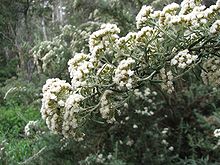- Ozothamnus secundiflorus
-
Ozothamnus secundiflorus 
Ozothamnus secundiflorus at Mount Donna Buang, Victoria Scientific classification Kingdom: Plantae (unranked): Angiosperms (unranked): Eudicots (unranked): Asterids Order: Asterales Family: Asteraceae Tribe: Gnaphalieae Genus: Ozothamnus Species: O. secundiflorus Binomial name Ozothamnus secundiflorus
(N.A.Wakef.) C.Jeffrey[1]Synonyms Helichrysum secundiflorum N.A.Wakef.
Ozothamnus secundiflorus (Cascade Everlasting) is an aromatic shrub species, endemic to Australia. It grows to between 0.5 and 2 metres in height. Leaves are 6 to 10 mm long and 1.5 to 4 mm wide. These are dark green with grey hairs on the upper surface, and white tomentose below.[2] The white flowerheads which appear in dense clusters along one side of the stem between December and February in the species native range.[2][3]
The species was first formally described as Helichrysum secundiflorum by N.A. Wakefield in The Victorian Naturalist in 1951, based on plant material collected from Mount Cobberas by botanist Ferdinand von Mueller in 1854. The species was transferred to the genus Ozothamnus by C.Jefferey in 1976 in Trees & Shrubs Hardy in the British Isles [1]It occurs in open woodland in subalpine and sheltered alpine areas of New South Wales and Victoria.[3] It is commonly seen amongst rocks in association with Eucalyptus pauciflora.[2]
References
- ^ a b "Ozothamnus secundiflorus". Australian Plant Name Index (APNI), IBIS database. Centre for Plant Biodiversity Research, Australian Government. http://www.anbg.gov.au/cgi-bin/apni?taxon_id=65007.
- ^ a b c Costermans, L. (1981). Native Trees and Shrubs of South-eastern Australia. Australia: Rigby. ISBN 072701403x.
- ^ a b "Ozothamnus secundiflorus". PlantNET - New South Wales Flora Online. Royal Botanic Gardens & Domain Trust, Sydney Australia. http://plantnet.rbgsyd.nsw.gov.au/cgi-bin/NSWfl.pl?page=nswfl&lvl=sp&name=Ozothamnus~secundiflorus=. Retrieved 2009-12-26.
Categories:- Gnaphalieae
- Asterales of Australia
- Flora of New South Wales
- Flora of Victoria (Australia)
- Asteraceae stubs
- Australian asterid stubs
Wikimedia Foundation. 2010.
